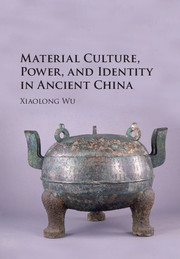Book contents
- Frontmatter
- Dedication
- Contents
- List of Figures
- List of Maps
- List of Tables
- Acknowledgments
- INTRODUCTION
- 1 HISTORICAL SETTING AND APPROACHES TO THE STUDY OF AN ANCIENT STATE IN WARRING STATES CHINA
- 2 LIFE, DEATH, AND IDENTITY IN ZHONGSHAN: SORTING OUT THE ARCHAEOLOGICAL EVIDENCE
- 3 ROYAL MORTUARY PRACTICE AND ARTIFACTS: HYBRIDITY, IDENTITY, AND POWER
- 4 INTERSTATE POLITICS AND ARTISTIC INNOVATION DURING THE REIGN OF KING CUO
- 5 STATECRAFT AND ZHONGSHAN BRONZE INSCRIPTIONS
- 6 FUNERARY ARCHITECTURE, KINGLY POWER, AND COURT POLITICS
- CONCLUSION
- Appendices
- Notes
- Bibliography
- Index
3 - ROYAL MORTUARY PRACTICE AND ARTIFACTS: HYBRIDITY, IDENTITY, AND POWER
Published online by Cambridge University Press: 23 March 2017
- Frontmatter
- Dedication
- Contents
- List of Figures
- List of Maps
- List of Tables
- Acknowledgments
- INTRODUCTION
- 1 HISTORICAL SETTING AND APPROACHES TO THE STUDY OF AN ANCIENT STATE IN WARRING STATES CHINA
- 2 LIFE, DEATH, AND IDENTITY IN ZHONGSHAN: SORTING OUT THE ARCHAEOLOGICAL EVIDENCE
- 3 ROYAL MORTUARY PRACTICE AND ARTIFACTS: HYBRIDITY, IDENTITY, AND POWER
- 4 INTERSTATE POLITICS AND ARTISTIC INNOVATION DURING THE REIGN OF KING CUO
- 5 STATECRAFT AND ZHONGSHAN BRONZE INSCRIPTIONS
- 6 FUNERARY ARCHITECTURE, KINGLY POWER, AND COURT POLITICS
- CONCLUSION
- Appendices
- Notes
- Bibliography
- Index
Summary
IN ORDER TO DISCOVER THE HUMAN AGENCY BEHIND THE ARCHAEOLOGICAL remains, this chapter will zoom in and focus on the royal tombs, especially that of King Cuo. Some peculiar aspects of Cuo's mortuary practice, tomb structure, and artifacts reveal patterns that beg to be interpreted in relation to identity and power. What was included in these tombs and how was it arranged spatially within the symbolic framework of mortuary structures? How do we make sense of the diverse cultural elements in Zhongshan royal mortuary practice and artifacts? These questions can be answered from various perspectives, and this analysis aims to bring the choices and intentions of the royal personages and their agents to the fore, and to examine how royal power and prestige were constructed and embellished visually.
ROYAL CEMETERIES
At the capital, Lingshou, two locations were used as burial sites for three generations of Zhongshan rulers (Map 0.2). The earlier location is in the northern part of the west city, protected by city walls on all four sides. This cemetery, taking up about one-eighth of the whole city of Lingshou, contains the tombs of two Zhongshan rulers and their auxiliary tombs. The group of tombs in the north, still unexcavated, includes the tomb of a Zhongshan ruler (M7), three outlying horse-and-chariot pits to its south, six auxiliary tombs to its northwest, the tomb of his primary consort to its east (M8), and an auxiliary tomb to M8. The group of tombs in the south is centered on M6, identified as the tomb of King Cheng of Zhongshan, which has two outlying horse-and-chariot pits and three auxiliary tombs. Three tombs (M3, M4, and M5), identified as those of Zhongshan royal family members, are lined up to its west; each of the three tombs has a horse-and-chariot pit and two of them (M3 and M4) have an auxiliary tomb each. All tombs in the southern group have been excavated, but the main tombs had all been severely looted.
The second location is around 1,500 meters to the west of the city, at the southern foot of a low hill, and has two huge tomb mounds. One of them and its auxiliary tombs and sacrificial pits were excavated in the 1970s and it has proven to be the resting place of a Zhongshan king named Cuo based on epigraphic evidence from the tomb.
- Type
- Chapter
- Information
- Material Culture, Power, and Identity in Ancient China , pp. 77 - 133Publisher: Cambridge University PressPrint publication year: 2017



